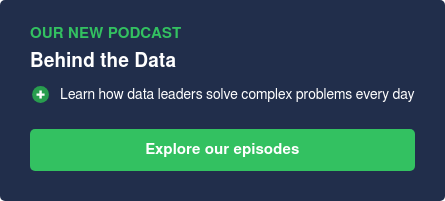Much like an ‘ordinary’ architect, a data architect designs the blueprint of a company’s data strategy and architecture. Data engineers then use these designs to build databases and other systems.
However, this is a very simple explanation. And a data architect’s job responsibility list is exhaustive.
So, here’s our quick overview.
What does a data architect do?
We don’t envy data architects - their job responsibility list is exhaustive.
Broadly speaking, a data architect creates a data management framework full of procedures, policies and rules. This standardizes an organization’s data management processes and bridges the gap between business needs and IT considerations.
That said, their duties depends on their workplace. Large organizations, such as government bodies, may employ multiple data architects, senior data architects, and a chief data architect. Their job duties will differ. On the other hand, smaller organizations may blend the role of data engineer and data architect.
But, generally speaking, these are four of a data architect’s top responsibilities:
1. Work with business and IT leaders
As we’ve already mentioned, a data architect sits between business and IT. As a result, the data architecture they design must adhere to their organization’s objectives, as well as wider industry requirements.
For example, c-suite executives may want to increase the quality and accessibility of data insights to help them improve decision-making. Therefore, a data architect will make this a priority.
That said, they will provide advice or pushback if something isn’t technically viable.
2. Create data models, metadata systems, and pipelines
These form the pillars of an organization’s data management framework and principles.
They dictate how your business collects, accesses, manages, distributes and retrieves data throughout its lifecycle. They also ensure you:
- Meet regulatory requirements
- Maintain data quality
- Secure your information
In addition to these more technical artefacts, a data architect will also define and communicate a common data vocabulary. This helps to establish data consistency.
3. Oversee internal and external teams
Like a building architect overseeing a construction crew laying the foundations for a new build, a data architect will supervise the work of data engineers. This is to ensure they construct databases, applications and other data systems in accordance with their framework.
Depending on the maturity of their data team, they may also liaise with external data suppliers to develop specifications that meet the needs of their architecture.
4. Identify new technologies and processes
Whether it’s embracing cloud-based data platforms or slick data integration tools, a data architect will look for ways to modernize their data architecture.
Ultimately, the slicker the data architecture, the more value a business can unlock.
Do you need a data architect? 3 signs it’s time for an expert
Let’s rephrase this question. Would you build a home without designing a sound blueprint first? Of course you wouldn’t.
While your data architecture may ‘do’ for the time being, cracks could appear further down the line. These could include employee frustrations, questionable analytics, and inaccessible data.
With that in mind, here are three signs it’s time for an architect.
1. You have a silo problem
Let’s continue with the house analogy for a moment. Imagine your business is a mansion, and each room contains a business function, such as sales or HR. Now imagine these rooms have no doors or windows.
That’s a data silo. Your teams may own a wealth of valuable data, but you’ll never see it unless you find a way in. Unfortunately, these data siloes can cause a number of problems, including:
- The inability to share insights or unlock value
- Difficulty tracing and retrieving data for GDPR purposes
- Duplication or standardization issues
By hiring a data architect, you can improve the transparency and accessibility of your data. In turn, eliminating these challenges.
2. Your data is low-quality and untrustworthy
Do you frequently stumble across typos, missing data fields or duplications? Perhaps you still use out-of-date data, too.
The 6 biggest data integration challenges (and how to solve them)This all reduces your overall data quality, which can cause financial and security problems. Indeed, 44 percent of survey respondents claim they lose 10 percent of annual revenue because of low quality CRM data.
A data architect will standardize your data management processes, monitor data quality, and ensure you have one single source of truth.
3. Your insights are slow (or non-existent)
Twenty-seven percent of organizations say business intelligence is critical to their operations.
But it’s difficult to extract intelligence and make informed decisions when you’re living in data chaos.
A data architect orchestrates a modern enterprise data architecture that unlocks your data. They can ensure insights are easily accessible and regular. That way, you can make confident business decisions in a matter of minutes, rather than wait weeks or more for insights.
Architecting your business success
We talk a lot about the importance of good data architectures on our blog. But it’s easy to forget the brains behind them.
Data architects are integral for shaping data strategies, models, procedures and policies that enable business growth. Without them, you’ll struggle to consolidate, access, and protect your data.
So, don’t take them for granted. They’re the reason you can extract value from your data.
Looking for more data architecture insights? Read our in-depth enterprise data architecture guide.
.jpg)





847d.jpg?width=800&height=450&name=luke-van-zyl-koH7IVuwRLw-unsplash%20%281%29.jpg)